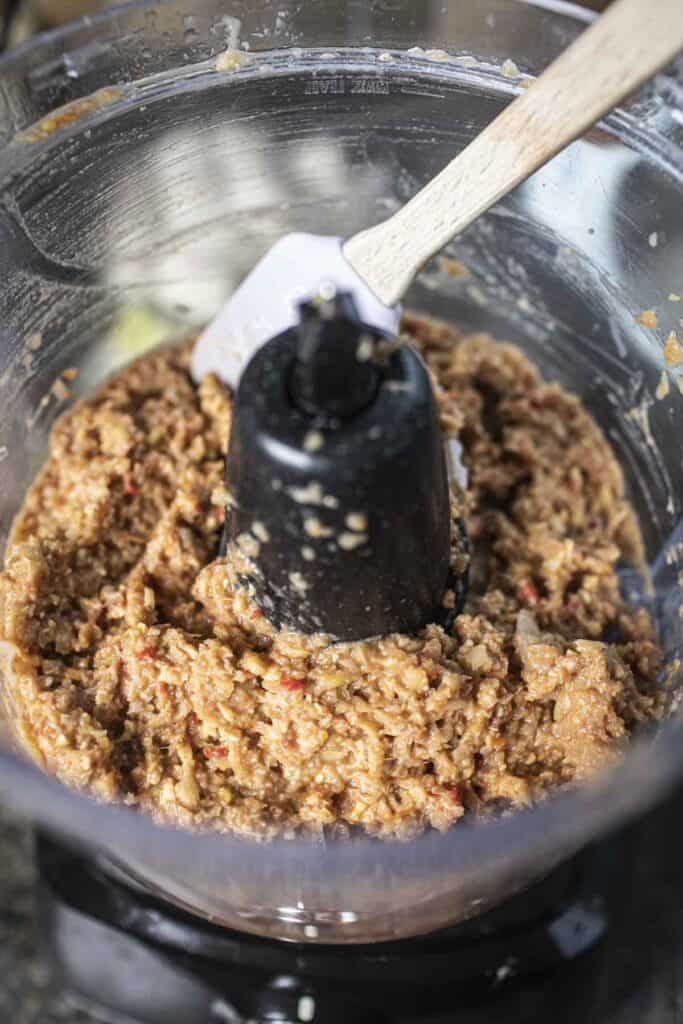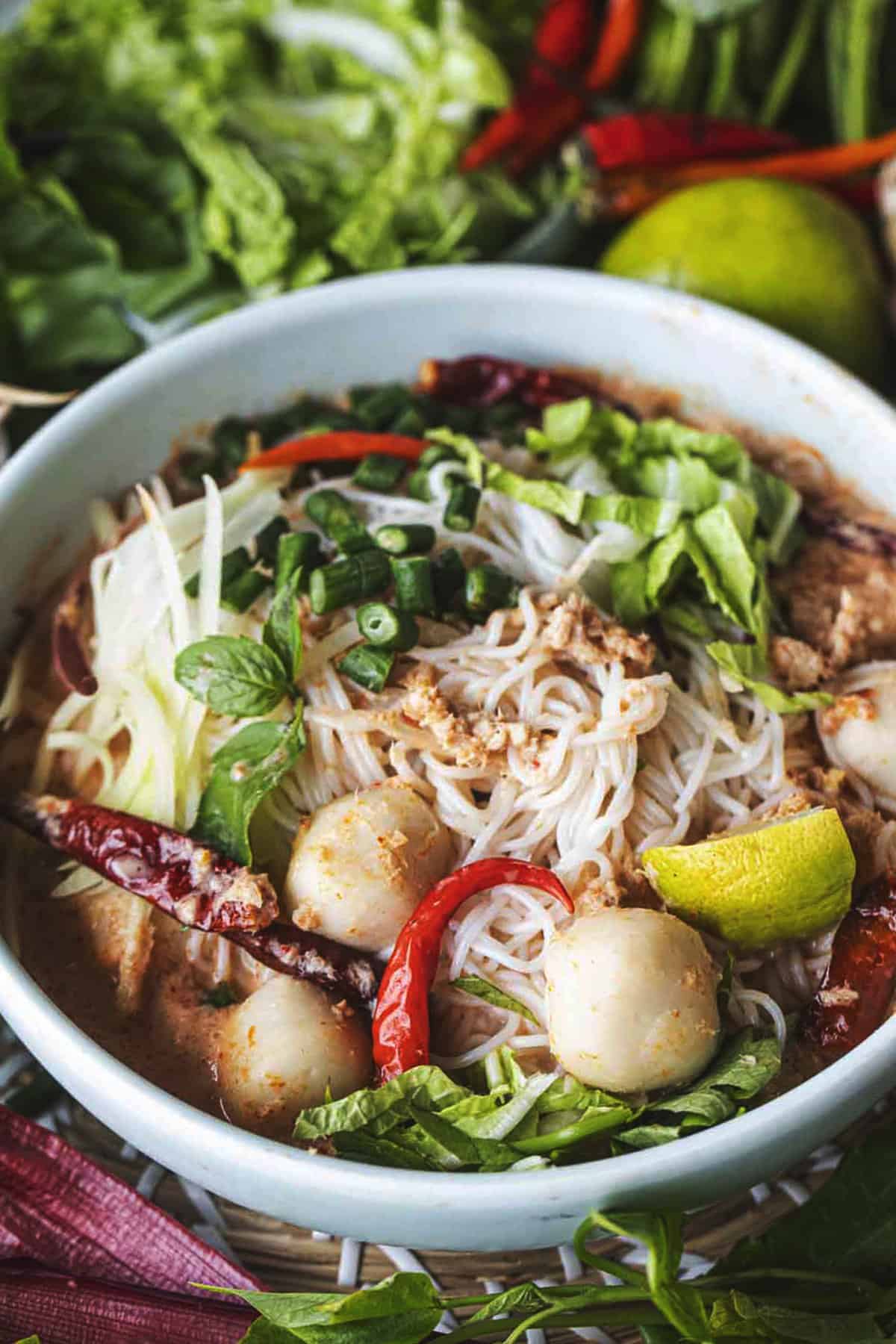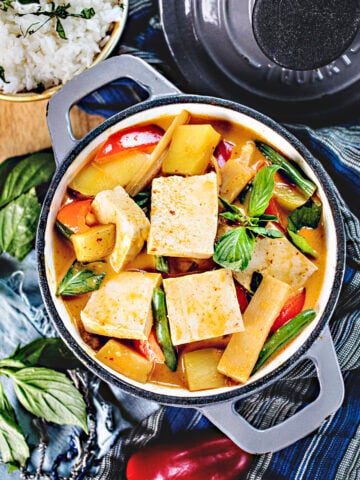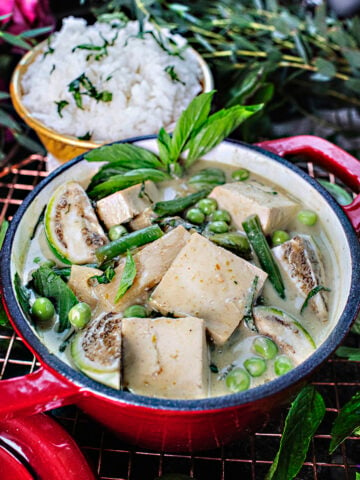Kanom Jeen Nam Ya Curry is a dream come true for Thai food fans. Made with love using soft noodles, umami fish broth seasoned with aromatic herbs, and garnished with fresh ingredients. Get ready to be hooked!

One of the main ingredients in Nam Ya curry is Krachai. Read more about this aromatic herbs here.
For more Thai fish curries, you'll also love Thai cod curry, Thai catfish stir fry with red curry paste, Salmon Choo Chee, Thai jungle curry, and Thai sour curry, Gaeng Som.
Jump to:
- What is Kanom Jeen Namya Curry?
- A Special Dish
- Different Varieties of Kanom Jeen Namya
- Why You'll Love Khanom Jeen Nam Ya Curry
- Ingredients for Kanom Jeen Namya Recipe
- The Noodles for Kanom Jeen Noodles
- Kanom Jeen Noodles Substitutes
- The Nam Ya Curry Paste
- Nam Ya Sauce
- The Toppings & Garnishes
- How to Make Kanom Jeen Namya Curry
- Tips for the Perfect Kanom Jeen Namya Curry
- Serving Tips
- Storage
- Variations & Substitutes
- Helpful Kitchen Tools for This Recipe
- Related Thai Recipes You May Like
- Frequently Asked Questions
- Kanom Jeen Nam Ya (Thai Fish Curry with Rice Noodles)
- Related
Kanom Jeen Nam Ya Curry is my all-time favorite curry. EVER.
This yummy dish will take your taste buds on a flavor adventure. Imagine soft rice noodles in a heavenly fish and coconut curry sauce, bursting with deliciousness in every mouthful! Yum!
What is Kanom Jeen Namya Curry?
If you are a fan of Thai cuisine, you must try the iconic dish Kanom Jeen Namya Curry. It features the delicious Kanom Jeen, tender fermented rice noodles served in a fragrant fish curry sauce and topped with crunchy vegetables and fresh aromatic herbs.
Every spoonful is bursting with flavors that Thai food enthusiasts adore.
Some call it Thai spaghetti, but let me tell you, the Thai version is way more amazing. I might be slightly biased, but trust me, it's absolutely delicious!
A Special Dish
This dish holds a special place in my heart because it's my village's go-to dish for celebrations. Whether it's a wedding, funeral, or festival, you can always count on NamYa being served.
Different regions in Thailand have their own twists on this dish, but the version I'll be showing you today uses coconut milk for a creamy texture.
Don't worry. It's not too spicy, but add more chilis if you like some heat.
Different Varieties of Kanom Jeen Namya
There are so many different versions of Kanom Jeen Namya, each with its own unique flare using various types of sauces. In this version, I'll show you how to make a creamy Kanom Jean Namya with coconut milk.
It's slightly milder in spiciness, but you can adjust the heat by adding more chilis according to your taste.
Here are some examples of the different ways to have your Kanom Jeen Namya throughout Thailand.
- In southern Thailand, a delicious dish called Kanom Jean Namya is made using coconut milk from the abundant coconut groves in the region. A sweet version of this dish is called Nam Ya Kati Pak Tai (Southern Coconut Nam Ya).
- Nam Ngeow uses elaborate ingredients like meat and blood cakes in Northern Thailand.
- In central Thailand, there's the green curry with Kanom Jeen noodles.
- In Issan, my home region, Kanom Jean Nam Ya, you are made without coconut milk. Instead, we add Pla Ra, a pungent fermented fish sauce, for the unique flavors of the northeastern style.
Why You'll Love Khanom Jeen Nam Ya Curry
- It's a home-cooked meal at its best! This dish is a bit involved to make, so you won't find it in most Thai restaurants.
- This dish is healthy! It's full of aromatic herbs and spices that are dense in health benefits, as well as the added veggies that you can load up on your plate!
- The curry sauce stays in the fridge for a few days and can be frozen for up to 2 months!
- It's easily customizable. You can load up on meatballs and veggies, add extra sauce, or add some noodles without veggies.
- It's perfect for a party or a large gathering. Double or quadruple the quantity and make a buffet-style meal for your family potluck or a Sunday lunch meal!
Ingredients for Kanom Jeen Namya Recipe
Essential ingredients are important to making this iconic Thai dish. This noodle dish has four easy parts. Each part is easy to make, and each part adds to the layers of flavors and texture of Nam Ya.

The Noodles for Kanom Jeen Noodles
Let's talk about Kanom Jeen noodles for a moment. These noodles are a crucial component of this curry dish. The traditional way of making Kanom Jeen fresh rice noodles in Thai cuisine requires patience.
It involves manually squeezing a mixture of rice flour and water through a tool that resembles a ricer, creating long strands of noodles. These noodles are then allowed to ferment for a few days to develop their unique flavor, similar to sourdough bread.
Once fermented, the noodles are skillfully arranged in circular patterns, forming beautiful layers of long white noodles. These individual sheets of noodles are then used in Nam ya noodles.
In America, I have never seen fresh Kanom Jeen noodles sold anywhere, even in Asian markets. However, there are a few substitutions I've found over the years that work really well.
Read more about the different types of Thai noodles here.
Kanom Jeen Noodles Substitutes
You have a few options for the Kanom Jeen noodle substitutes. Traditional Thai cooking involves making fresh rice noodles, which can be time-consuming. But don't worry—these alternatives work just as well.

- Vietnamese vermicelli noodles. These are the same noodles used in spring rolls. There are different sizes, so pick your favorite and cook to package and Cook to package instructions. See the image above for brands I love.
- Japanese soba noodles. Use the white Japanese soba noodles rolled up in a black wrapper the size of two fingers. Cook to package instructions.
- Buckwheat noodles can work as a last resort. They don't have the ideal texture, as they are too thick and starchy. That tends to diminish the flavors of Nam Ya Curry sauce.
- Use vegetables as noodles. Shredded green papaya, nappa, or cabbage are excellent options for a low-carb version. My favorite is shredded green papaya.
The Nam Ya Curry Paste
These key ingredients below make the Nam Ya curry paste different from all the other Thai curry pastes. Krachai is particularly important for this recipe.
See the image below for reference. Grab them frozen or brined in a jar at the Asian markets.

- Whitefish. I used tilapia for this recipe, but any mild white fish will work, including snakehead and bass. In Thailand, salted mackerel, frozen or fresh fish, will be fine.
- Dried chilies. Use Thai spur chile and bird's eye chiles. Modify as needed for spice level tolerance. Read more about Thai spices here.
- Krachai. These are a must for this recipe. These are also called finger roots, wild ginger, or Chinese keys. Read more about the different Thai fresh herbs here. Find them in the frozen section at Asian grocery stores.
- Lemongrass. Chop them into small pieces before cooking.
- Galangal. Galangal can be difficult to find. They can be found in the Asian market. Slice the brown peel off and use only the white part. Ginger is not a good substitute. Omit if you can't find galangal.
- Kaffir lime leaves. More about Kaffir lime leaves here.
- Garlic. Adds on to the flavors of the paste.
- Shallot. Purple onions are not recommended as substitutes.
- Salt. Adds a sharp, salty flavor to balance out the creamy sauce.
- Shrimp paste. This is where the extra umami is packed in!
Read more about essential Thai ingredients here.
Nam Ya Sauce
- Coconut milk (13.5 ounces). Make your own coconut milk here using these coconut-cracking methods.
- Water. Use low to no salt stock if desired.
- Fish balls. You can leave them whole or slice them in halves. You can find these in the freezer section at Asian markets.
- Fish sauce. For the umami flavors.
- Lime juice. Just a little bit for a light, tangy balance.
The Toppings & Garnishes
Below, we suggest using a variety of fresh vegetables. Slice everything very thinly and in small pieces. Crunchy and leafy herbs are best for this recipe.
Some of Thai people's favorite vegetables, herbs, and seasonings are.
- Long beans. Any green beans are fine
- Cabbage, napa, or regular white or purple cabbage. The crunchy vegetables!
- Shredded green papaya. Use shredded papaya instead of noodles if you want a lower-carb option.
- Pickled mustard greens. Adds a tangy and fermented leafy texture to the curry.
- Thinly sliced cucumbers. English, Persian, or pickling fresh cucumbers only.
- Bean sprouts for the extra crunch.
- Very thinly sliced banana blossoms. One of my favorite garnishes for Nam Ya!
- Blanched bitter melon/ goya. For a bold and bitter taste
- Water spinach (Pak Boung) is a mild and crunchy leafy green.
- Lemon basil and Thai basil will be fine, too.
- Cilantro or culantro is excellent as a garnish for fresh herbs. Read more about fresh Thai herbs here.
- Crispy fried shallot or fried garlic, chili garlic oil, Prik Nam Som (Thai Pickled Chili Vinegar Sauce) and Thai chili flakes are all great options for adding heat.
How to Make Kanom Jeen Namya Curry
1. Prepare the dry noodles. Add water and a pinch of salt to a medium pot, bring the water to a boil, and then cook the noodles according to the package instructions. After cooking, I also like to rinse all my noodles with cold water to help remove excess starch.


2. Make the herbal broth. Add the aromatics and salt to a separate medium pot of water. Bring to a boil and simmer for 15 minutes. Remove the aromatics from the hot water using a slotted spoon or wire mesh strainer. Set aside.

3. Make the fish broth. Add the fish to the pot and cook for 3-4 minutes. This is essentially making quick fish stock. Remove the fish and set aside.

4. Make the Nam Ya paste. Add the fish and the boiled ingredients, along with ⅓ cup of water, to a medium food processor. Blitz until you have a smooth paste.


5. Make the Nam Ya curry sauce. Add the paste back into the fish stock along with the coconut milk. Stir. Allow the sauce to boil softly, stirring a few times.
Please note. The more red peppers you use, the more orange/red your curry sauce will look. Using less red peppers means lighter curry sauce.

6. Seasoned to taste. Add the fish balls and cook for 2-3 more minutes—season the sauce with fish sauce, lime juice, and more salt. Add ground chilis or chili garlic oil if you would like more heat. Adjust seasoning to taste.


7. Putting it all together. In a large bowl, place the cooked noodles as the base, and add a generous amount of the curry sauce. Then go nuts with your favorite toppings using any of the recommended toppings and garnishes. (Check the above section).

Tips for the Perfect Kanom Jeen Namya Curry
- Leave some fish out in larger pieces to add to the curry sauce. The chunky meat adds a meaty texture.
- If using banana blossoms, which can be found at Asian markets, sprinkle some lime juice over the sliced pieces to prevent them from browning.
- Lemon basil pairs extremely well with Kanom Jean Namya. However, lemon basil is more difficult to find. I often make this dish around mid-to-late summer, when lemon basil is more available.
Serving Tips
- Garnish with fresh herbs and a squeeze of lime juice before serving.
- Accompany with som tam (green papaya salad), Laos papaya salad, spicy cucumber salad, or Gai Tod, Thai fried chicken wings for a complete Thai dining experience.
Storage
Any leftovers can be stored in an airtight container in the refrigerator for up to two days. Separate the ingredients to keep them fresher longer.
For the best leftovers, keep the noodles, sauce, and toppings in separate containers. Reheat the sauce gently on the stovetop or in the microwave before serving.
Variations & Substitutes
- Substitute freshwater fish with shrimp for a different twist.
- Kanom Jeen Namya can be served with green curry by simply using green curry paste as the base for the sauce.
- Use pork or beef balls instead of fish balls for a meatier taste.
Helpful Kitchen Tools for This Recipe
- Food processor for blending the curry sauce
- Stockpot for boiling the noodles
- Ladle for serving the curry

Related Thai Recipes You May Like
- Crab curry Boo Pong Karee
- Nam Prik Pao, Thai chili paste
- Homemade Thai red curry paste
- Kanom Jeeb Thai Dumplings
- Thai Glass Noodle Salad with Shrimp
Frequently Asked Questions
Kanom Jeen translates to "rice noodles" in English.
Khanom Chin Nam Ngiao is a northern Thai dish featuring rice noodles with a spicy pork or beef sauce.
Use your leftover Nam Ya sauce over rice, salads, or noodles to add a tangy and spicy kick.
Use as many or as few Kanom Jeen noodles as you'd like! Keep in mind that you will also add the sauce and a ton of toppings to the bowl to complete the dish.
**Love a recipe you've tried? Please leave a 5-star rating in the recipe card below and a review in the comments section further down the page. Or follow me on Facebook, Pinterest, or Instagram!**
Print
Kanom Jeen Nam Ya (Thai Fish Curry with Rice Noodles)
- Total Time: 40 minutes
- Yield: 8 servings
- Diet: Gluten Free
Description
Kanom Jeen Nam Ya Curry is a dream come true for Thai food fans, made with care using soft noodles, umami fish broth seasoned with aromatic herbs, and garnished with fresh ingredients. Get ready to be hooked!
Ingredients
Kanom Jeen Noodles Recommendations
Use the entire package for this recipe.
- Vietnamese vermicelli noodles. These are my favorite. They are the same noodles used in spring rolls. There are different sizes, so pick your favorite and cook to package and Cook to package instructions. See the image in the post for brands I love.
- Japanese soba noodles. Use the white Japanese soba noodles rolled up in a black wrapper the size of two fingers. Cook to package instructions.
- Buckwheat noodles can work, but they are not the best in texture. They are too thick and tend to take away from the flavors of Nam Ya Curry sauce.
- Use vegetables as noodles. Use shredded green papaya, nappa, or cabbage. This is an excellent option for a low-carb version. My favorite is shredded green papaya.
The Nam Ya Curry Paste
- ½ pound white fish. I used tilapia for this recipe. Any mild white fish will work. Snakehead, Cod, Snapper, Cod, Haddock, Pollock, Bass, and River Trout are great.
- 1-15 dried chilies. Use Thai spur chile and bird's eye chiles. Use more or less as needed for spice level tolerance. Read more about Thai spices here.
- 2 ounces krachai. These are a must for this recipe. These are also called finger roots, wild ginger, or Chinese keys. Find them in the frozen section at Asian grocery stores. See image in the main blog post for reference.
- 2 stalks, lemongrass. Chop them into small pieces before cooking.
- 4-quarter-sized sliced galangal. Galangal can be difficult to find. They can be found in the Asian market. Sliced the brown peel off and use only the white part. Ginger is not a good substitute. Omit if you can't find galangal.
- 3 kaffir lime leaves. More about Kaffir lime leaves here.
- 6 cloves garlic
- 2 ounces shallot
- 2 teaspoons salt
- 1 ½ tablespoons shrimp paste. Read more about essential Thai ingredients here.
Nam Ya Sauce
- 1 can coconut milk (13.5 ounces). Make your own coconut milk here using these coconut-cracking methods.
- 6 cups water
- 1 pound fish balls, 2 cups. Leave them whole or sliced in halves.
- 2 tablespoons fish sauce
- 1 tablespoon lime juice
The Toppings & Garnishes
Using a variety of fresh vegetables is suggested below. Slice everything very thinly and in small pieces. Crunchy and leafy herbs are best for this recipe.
- Long beans. Any green beans are fine.
- Cabbage, napa, or regular white or purple cabbage. The crunchy vegetables!Shredded green papaya. Use shredded papaya instead of noodles if you want a lower-carb option.
- Pickled mustard greens. Adds a tangy and fermented leafy texture to the curry.
- Thinly sliced cucumbers. English, Persian, or pickling fresh cucumbers only.
- Bean sprouts for the extra crunch.
- Very thinly sliced banana blossoms. One of my favorite garnishes for Nam Ya! Blanched bitter melon/ goya. For a bold and bitter taste
- Water spinach (Pak Boung) is a mild and crunchy leafy green.
- Lemon basil and Thai basil will be fine too.
- Cilantro or culantro are excellent as fresh herbs garnish. Read more about fresh Thai herbs here.
- Crispy fried shallot or fried garlic, chili garlic oil, Prik Nam Som (Thai Pickled Chili Vinegar Sauce) and Thai chili flakes are great options for added heat.
Instructions
1. Prepare the dry noodles. In a medium pot, add water and a pinch of salt, bring water to a boil, and then cook the noodles according to package instructions. I also like to rinse all my noodles with cold water after cooking them to help remove excess starch.
2. Make the herbal broth. In a separate medium pot of water, add the aromatics and salt. Bring to a boil and simmer for 15 minutes. Remove the aromatics from hot water using a slotted spoon or wire mesh strainer. Set aside.
3. Make the fish broth. Add the fish to the pot. Cook for 3-4 minutes. You are essentially making a quick fish stock doing this. Remove the fish and set aside.
4. Make the Nam Ya paste. In a medium food processor, add the fish and the boiled ingredients along with ⅓ cup of water. Blitz until you have a smooth paste.
5. Make the Nam Ya curry sauce. Add the paste back into the fish stock along with the coconut milk. Stir. Allow the sauce to boil softly, stirring a few times.
Please note. The more red peppers you use, the more orange/red your curry sauce will look. Using less red peppers means lighter curry sauce.
6. Seasoned to taste. Add the fish balls and cook for 2-3 more minutes—season the sauce with fish sauce, lime juice, and more salt. Add ground chilis or chili garlic oil if you would like more heat. Adjust seasoning to taste.
7. Putting it all together. In a large bowl, place the cooked noodles as the base, and add a generous amount of the curry sauce. Then go nuts with your favorite toppings using any of the recommended toppings and garnishes. (Check the above section).
Notes
- Leave some fish out in larger pieces to add to the curry sauce. The chunky meat adds a meaty texture.
- If using banana blossoms, found at Asian markets, sprinkle some lime juice over the sliced pieces to keep them from browning.
- Lemon basil pairs extremely well with Kanom Jean Namya. They are more difficult to find. I often make this dish around mid to late summer when lemon basil is more available.
- Prep Time: 20
- Cook Time: 20
- Category: Curries
- Method: Stovetop
- Cuisine: Thai
** Thank you so much for visiting my blog! This is truly a passion for me. If you have enjoyed these recipes and appreciate the hard work I put into them, I would love it if you would share them with your friends! Your recommendation is the highest review I could hope for, and I’d appreciate it! **
Related
Looking for other recipes like this? Try these:









Joana R says
That's an amazing recipe, so healthy a d tasty! Go for it!